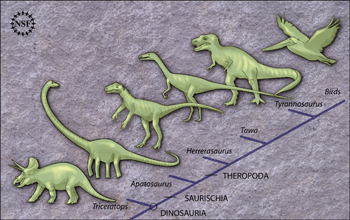Multimedia Gallery
New Dino Tawa hallae
Artists drawing based on analysis of how the newly discovered Triassic dinosaur, Tawa hallae, relates to other early dinosaurs. Researchers hypothesize that dinosaurs originated in what is now South America, and soon after diverged into ornithischians (like Triceratops), sauropodomorphs (like Apatosaurus) and theropods (like Tyrannosaurus rex), before dispersing across the Triassic world more than 220 million years ago. The theropods evolved into modern-day birds, although Tawa split off from the ancestral branch early on and was not a direct bird ancestor. Tawa was discovered during National Science Foundation-supported field excursions to Ghost Ranch, N.M.
This image accompanied NSF press release, "Newly Discovered Dinosaur Illuminates Ancient Lineage."
Credit: Zina Deretsky, National Science Foundation
Images and other media in the National Science Foundation Multimedia Gallery are available for use in print and electronic material by NSF employees, members of the media, university staff, teachers and the general public. All media in the gallery are intended for personal, educational and nonprofit/non-commercial use only.
Images credited to the National Science Foundation, a federal agency, are in the public domain. The images were created by employees of the United States Government as part of their official duties or prepared by contractors as "works for hire" for NSF. You may freely use NSF-credited images and, at your discretion, credit NSF with a "Courtesy: National Science Foundation" notation.
Additional information about general usage can be found in Conditions.
Also Available:
Download the high-resolution JPG version of the image. (1.5 MB)
Use your mouse to right-click (Mac users may need to Ctrl-click) the link above and choose the option that will save the file or target to your computer.



